 No matter what season is in question, a centerpiece in a container planting can organize the planting, and enrich the visual experience. Fall in my zone means a limited selection of plants grow at a vastly reduced rate. My summer pots have nicotiana mutabilis topping 6 feet now-none of my fall plants will grow like this. I have no objection to creating a centerpiece in a fall pot from natural materials that have already grown up, and been harvested. A case of really beautiful bittersweet arrived a few days ago-I could not wait to use it in some fall container plantings.
No matter what season is in question, a centerpiece in a container planting can organize the planting, and enrich the visual experience. Fall in my zone means a limited selection of plants grow at a vastly reduced rate. My summer pots have nicotiana mutabilis topping 6 feet now-none of my fall plants will grow like this. I have no objection to creating a centerpiece in a fall pot from natural materials that have already grown up, and been harvested. A case of really beautiful bittersweet arrived a few days ago-I could not wait to use it in some fall container plantings.
 Other natural materials are from places far from my home. Bahia spears-I have not the faintest idea what plant produced these stems. They are stiff and woody; these chocolate and gold stems look just like fall. Dried natural materials are an element that can spice up a fall planting. I love each and every one of my living plants, but the ability to create a shape from natural materials, and integrate that into a planting is great fun-try it!
Other natural materials are from places far from my home. Bahia spears-I have not the faintest idea what plant produced these stems. They are stiff and woody; these chocolate and gold stems look just like fall. Dried natural materials are an element that can spice up a fall planting. I love each and every one of my living plants, but the ability to create a shape from natural materials, and integrate that into a planting is great fun-try it!
 The base of this centerpiece-a pair of broomcorn shocks. Broomcorn-yes, this plant has been widely grown for for brooms. This means the stalks are stiff and weather impervious. The seed heads come in a range of colors from cream to red to black. I zip tie several bunches around a stout bamboo stake. That stake will keep my centerpiece straight up and down, no matter the weather. Zip ties-love them. They hold the heaviest centerpiece together. I use lots of them, in the early stages of construction.
The base of this centerpiece-a pair of broomcorn shocks. Broomcorn-yes, this plant has been widely grown for for brooms. This means the stalks are stiff and weather impervious. The seed heads come in a range of colors from cream to red to black. I zip tie several bunches around a stout bamboo stake. That stake will keep my centerpiece straight up and down, no matter the weather. Zip ties-love them. They hold the heaviest centerpiece together. I use lots of them, in the early stages of construction. This centerpiece is ready; there are three layers- all zip tied to a stake. The lower tier-10 faux grass stems. Fault me if you will for the fake statement, but anything that pleases my eye is ok. The long portion of this stake will be set way down into to soil of a pot. This stake is an anchor, and a rudder. A centerpiece gone out of level is not a good look. The centerpieces need to stand up straight. The beauty of any design depends on what your eye can believe. This centerpiece has a ways to go, before I would call it finished.
This centerpiece is ready; there are three layers- all zip tied to a stake. The lower tier-10 faux grass stems. Fault me if you will for the fake statement, but anything that pleases my eye is ok. The long portion of this stake will be set way down into to soil of a pot. This stake is an anchor, and a rudder. A centerpiece gone out of level is not a good look. The centerpieces need to stand up straight. The beauty of any design depends on what your eye can believe. This centerpiece has a ways to go, before I would call it finished.
 This three tiered centerpiece gets some air from the bittersweet vine sections, and a welcome shot of fall color. I cut the stems on an extreme angle, and work them under the zip tie. These wild and curving stems will start to loosen up that strictly zip tied affair. I use lots of zip ties in the construction of a centerpiece, as it will need to travel to the job. Should you be constructing a fall centerpiece for a treasured pair of pots-go large, go tall-be loose. The ties you do not really need once the entire container is finished can be cut off, for a looser yet effect.
This three tiered centerpiece gets some air from the bittersweet vine sections, and a welcome shot of fall color. I cut the stems on an extreme angle, and work them under the zip tie. These wild and curving stems will start to loosen up that strictly zip tied affair. I use lots of zip ties in the construction of a centerpiece, as it will need to travel to the job. Should you be constructing a fall centerpiece for a treasured pair of pots-go large, go tall-be loose. The ties you do not really need once the entire container is finished can be cut off, for a looser yet effect.
 My centerpiece made the trip to the job without any damage. It is very heavy, but easy to handle. My crews handle anything I send their way with aplomb. The fabric you see draped over the edge of a pot keeps the pot from getting dirty on the rim. The tarp on the ground is there for the same reason. A little care keeps the cleanup part fast and easy. The Redbor kale are the center plants. These we plant first, so its easy to tell exactly where the centerpiece goes. Getting the centerpiece in the center is as important as making sure it is perfectly upright.
My centerpiece made the trip to the job without any damage. It is very heavy, but easy to handle. My crews handle anything I send their way with aplomb. The fabric you see draped over the edge of a pot keeps the pot from getting dirty on the rim. The tarp on the ground is there for the same reason. A little care keeps the cleanup part fast and easy. The Redbor kale are the center plants. These we plant first, so its easy to tell exactly where the centerpiece goes. Getting the centerpiece in the center is as important as making sure it is perfectly upright.
 Levelling the centerpiece takes some time-and at least four hands. Once that centerpiece is set, level, and solid, we tweak. The top most zip tie-we cut that off. We move this element up, we move that element down. We deconstruct what we constructed. This is the most important part. A centerpiece has to be strong and securely made. But how it gets loosened up is what creates a very natural look.
Levelling the centerpiece takes some time-and at least four hands. Once that centerpiece is set, level, and solid, we tweak. The top most zip tie-we cut that off. We move this element up, we move that element down. We deconstruct what we constructed. This is the most important part. A centerpiece has to be strong and securely made. But how it gets loosened up is what creates a very natural look.
 All of the elements of the centerpiece gets adjusted after it is installed. I try to integrate it with the living material in such a way that it all looks lively, and of a piece.
All of the elements of the centerpiece gets adjusted after it is installed. I try to integrate it with the living material in such a way that it all looks lively, and of a piece.
Fall plantings are all about some cabbages, some mums, some late representing grasses, the pansies-those plants that tolerate cold temperatures. But fall container plantings are greatly about that gardener that has a mind to represent fall in a way they think is beautiful.
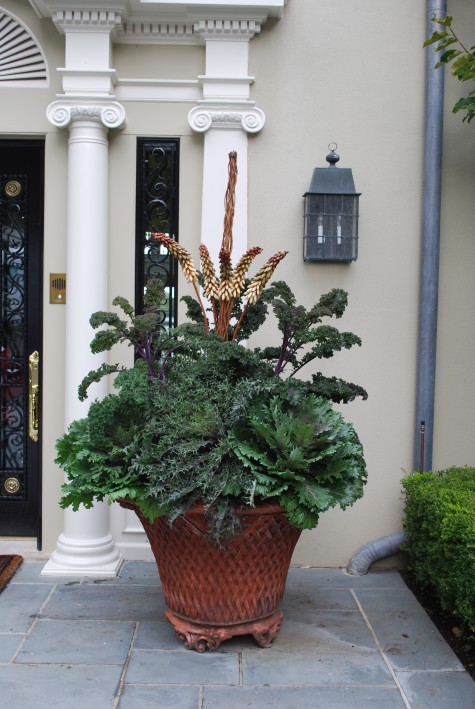 What is in your yard, drying, now? Sounds like a centerpiece to be, to me.
What is in your yard, drying, now? Sounds like a centerpiece to be, to me.
 If your yard is light on materials that might work in a container, your local nursery or famer’s market is bound to have something. There are lots of possibilities for fall pots- make the most of having a choice. Your fall pots have lots of possibilities. Make much of the fall plants that tolerate the cold. Make more of putting it all together.
If your yard is light on materials that might work in a container, your local nursery or famer’s market is bound to have something. There are lots of possibilities for fall pots- make the most of having a choice. Your fall pots have lots of possibilities. Make much of the fall plants that tolerate the cold. Make more of putting it all together.

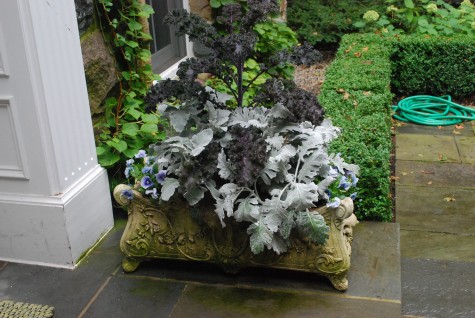






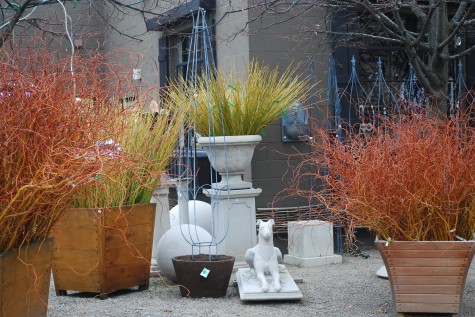

 Window boxes of size permit expression of size. These boxes are viewed primarily from a garden room indoors, so big and striking, and not too tall, is the order of the day. As they face the south, and are somewhat protected from freezing winds and cold temperatures, these boxes prosper late into the fall season and through Thanksgiving.
Window boxes of size permit expression of size. These boxes are viewed primarily from a garden room indoors, so big and striking, and not too tall, is the order of the day. As they face the south, and are somewhat protected from freezing winds and cold temperatures, these boxes prosper late into the fall season and through Thanksgiving.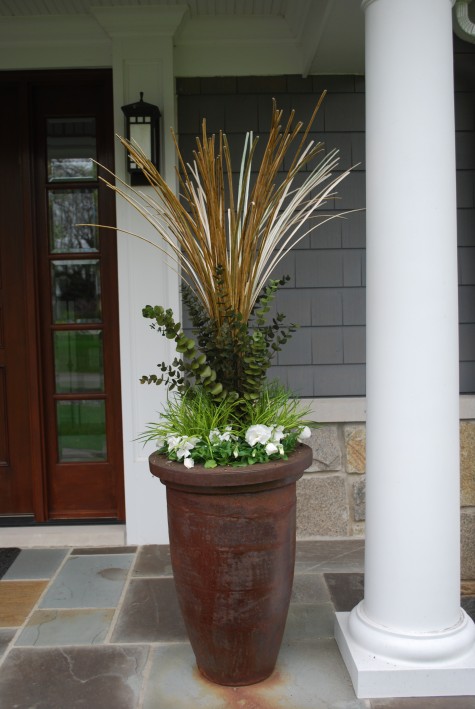 Whomever it was who invented stick stacks, I thank them. These 6 foot stacks comprised of wood cut into quarter inch by quarter inch squares are uniformly vertical when they go in a pot. A piece of steel rebar is driven deep into the pots, and the stack wired to it. This keeps the centerpiece from tilting. Funny how an element askew has that air of neglect about it. I like to see people keeping up the appearance of their homes from the street. Stick stacks change in appearance with exposure to weather. As the wood absorbs moisture from the air, they curve away from the center in a very graceful way. The preserved green eucalyptus weathers just about anything.
Whomever it was who invented stick stacks, I thank them. These 6 foot stacks comprised of wood cut into quarter inch by quarter inch squares are uniformly vertical when they go in a pot. A piece of steel rebar is driven deep into the pots, and the stack wired to it. This keeps the centerpiece from tilting. Funny how an element askew has that air of neglect about it. I like to see people keeping up the appearance of their homes from the street. Stick stacks change in appearance with exposure to weather. As the wood absorbs moisture from the air, they curve away from the center in a very graceful way. The preserved green eucalyptus weathers just about anything. Tender is a fabulous dress shop that is known for its cutting edge fashion. Their fall pots are dressy. Maple leaves coated in copper shine, as do the pumpkins with a dusting of gold. Integrifolia dyed an intense shade of fall orange compliment the dyed pencil thin willow sticks. Orange and white pansies complete the ensemble.
Tender is a fabulous dress shop that is known for its cutting edge fashion. Their fall pots are dressy. Maple leaves coated in copper shine, as do the pumpkins with a dusting of gold. Integrifolia dyed an intense shade of fall orange compliment the dyed pencil thin willow sticks. Orange and white pansies complete the ensemble. This narrow courtyard, part of a condominium, is organized around four very large white concrete pots inlaid with bands of curved stainless steel wire. Fiber pots painted white in galvanized steel stands are home to my client’s tomato plants in the summer; the tall kale, pansies, and creeping jenny compliment the cabbages and ivy in the concrete pots in both form and feeling.
This narrow courtyard, part of a condominium, is organized around four very large white concrete pots inlaid with bands of curved stainless steel wire. Fiber pots painted white in galvanized steel stands are home to my client’s tomato plants in the summer; the tall kale, pansies, and creeping jenny compliment the cabbages and ivy in the concrete pots in both form and feeling.  Lime integrifolia and diamond shaped moss pillows help create a clean and more modern look; not every client is enamoured of pumpkins and the like. Bleached sticks and pods complete the look.
Lime integrifolia and diamond shaped moss pillows help create a clean and more modern look; not every client is enamoured of pumpkins and the like. Bleached sticks and pods complete the look.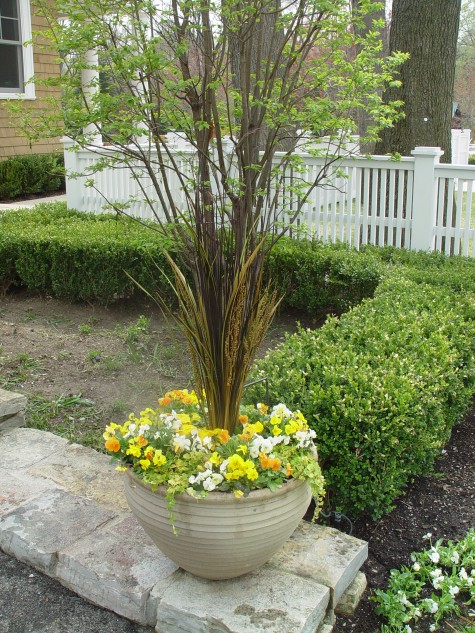

 Our weather has taken a turn towards fall; today’s 47 degree temperature is all the more chilly for the 35 mile an hour winds. I was so sure I would have my summer flowers into next week. My clients are much more graceful about moving on to the next season than I am-especially those clients with children. The Halloween holiday-what child isn’t entranced by it? A request for fall pots came from a client with children ready to devote the entire month of October to some ghoulishness.
Our weather has taken a turn towards fall; today’s 47 degree temperature is all the more chilly for the 35 mile an hour winds. I was so sure I would have my summer flowers into next week. My clients are much more graceful about moving on to the next season than I am-especially those clients with children. The Halloween holiday-what child isn’t entranced by it? A request for fall pots came from a client with children ready to devote the entire month of October to some ghoulishness. My favorite part of October is that group of leafy plants known as the Brassicas. They come into their own late in the gardening year. Though there is some disagreement about which plants belong to that group, cabbages, kales, cauliflower, and broccoli are prominent members. These cool season annuals are great to eat-but I love how they look. There are many hybrid cabbages and kale that are grown for the beauty of their leaves. As the weather cools, the color intensifies.
My favorite part of October is that group of leafy plants known as the Brassicas. They come into their own late in the gardening year. Though there is some disagreement about which plants belong to that group, cabbages, kales, cauliflower, and broccoli are prominent members. These cool season annuals are great to eat-but I love how they look. There are many hybrid cabbages and kale that are grown for the beauty of their leaves. As the weather cools, the color intensifies.  I am indebted to the Brassicas for their scale, mass and texture. Though many plants are tolerant of cold weather – the pansies, certain grasses and so forth-the cabbages and kales can be had of a good size. Our fall season is short, and not so much actual growing goes on. I like planting big right off the bat; some years the fall constitutes but a few weeks. They are not in the least bit fussy about planting depth. If I need to sink them in a pot for a better look, I do so.
I am indebted to the Brassicas for their scale, mass and texture. Though many plants are tolerant of cold weather – the pansies, certain grasses and so forth-the cabbages and kales can be had of a good size. Our fall season is short, and not so much actual growing goes on. I like planting big right off the bat; some years the fall constitutes but a few weeks. They are not in the least bit fussy about planting depth. If I need to sink them in a pot for a better look, I do so.
 A hazelwood stick covered with grapevine is sunk deep in the soil of the pot. Since wind and rain are more than likely, anchoring any dry materials in a sturdy way is essential. The pod sticks resembling a tritoma have been constructed from overscaled seeds. The entire assemby is glued up on the stick, and sealed. I do make a special effort to find materials like this that can withstand blustery weather.
A hazelwood stick covered with grapevine is sunk deep in the soil of the pot. Since wind and rain are more than likely, anchoring any dry materials in a sturdy way is essential. The pod sticks resembling a tritoma have been constructed from overscaled seeds. The entire assemby is glued up on the stick, and sealed. I do make a special effort to find materials like this that can withstand blustery weather.  The finished planting is a great scale with a pot this size. The hazelwood stick repeats the basketweave pattern of the pot, and the light colored seed pod stems make reference to the garden gone to seed. The curvy pods echo the curve of the tall kale leaves. I like fall pots with all manner of things in them that refer to the natural world.
The finished planting is a great scale with a pot this size. The hazelwood stick repeats the basketweave pattern of the pot, and the light colored seed pod stems make reference to the garden gone to seed. The curvy pods echo the curve of the tall kale leaves. I like fall pots with all manner of things in them that refer to the natural world.  The happy accident of this planting-how great those pale pods repeat the color and texture of the skeleton.
The happy accident of this planting-how great those pale pods repeat the color and texture of the skeleton. 